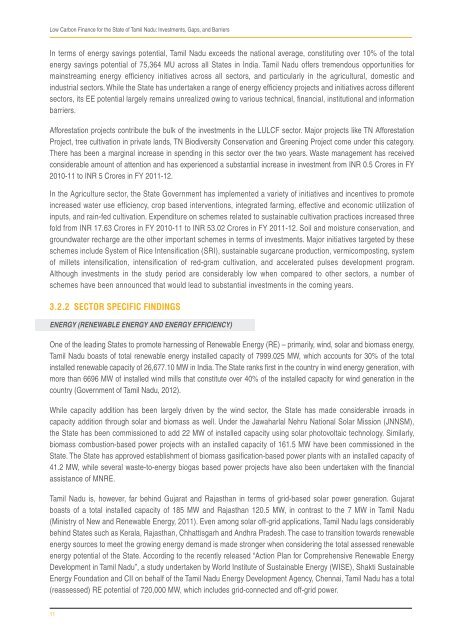Low-Carbon-Finance-for-the-State-of-Tamil-Nadu-Investments-Gaps-and-Barriers - Shakti Foundation
You also want an ePaper? Increase the reach of your titles
YUMPU automatically turns print PDFs into web optimized ePapers that Google loves.
<strong>Low</strong> <strong>Carbon</strong> <strong>Finance</strong> <strong>for</strong> <strong>the</strong> <strong>State</strong> <strong>of</strong> <strong>Tamil</strong> <strong>Nadu</strong>: <strong>Investments</strong>, <strong>Gaps</strong>, <strong>and</strong> <strong>Barriers</strong><br />
In terms <strong>of</strong> energy savings potential, <strong>Tamil</strong> <strong>Nadu</strong> exceeds <strong>the</strong> national average, constituting over 10% <strong>of</strong> <strong>the</strong> total<br />
energy savings potential <strong>of</strong> 75,364 MU across all <strong>State</strong>s in India. <strong>Tamil</strong> <strong>Nadu</strong> <strong>of</strong>fers tremendous opportunities <strong>for</strong><br />
mainstreaming energy efficiency initiatives across all sectors, <strong>and</strong> particularly in <strong>the</strong> agricultural, domestic <strong>and</strong><br />
industrial sectors. While <strong>the</strong> <strong>State</strong> has undertaken a range <strong>of</strong> energy efficiency projects <strong>and</strong> initiatives across different<br />
sectors, its EE potential largely remains unrealized owing to various technical, financial, institutional <strong>and</strong> in<strong>for</strong>mation<br />
barriers.<br />
Af<strong>for</strong>estation projects contribute <strong>the</strong> bulk <strong>of</strong> <strong>the</strong> investments in <strong>the</strong> LULCF sector. Major projects like TN Af<strong>for</strong>estation<br />
Project, tree cultivation in private l<strong>and</strong>s, TN Biodiversity Conservation <strong>and</strong> Greening Project come under this category.<br />
There has been a marginal increase in spending in this sector over <strong>the</strong> two years. Waste management has received<br />
considerable amount <strong>of</strong> attention <strong>and</strong> has experienced a substantial increase in investment from INR 0.5 Crores in FY<br />
2010-11 to INR 5 Crores in FY 2011-12.<br />
In <strong>the</strong> Agriculture sector, <strong>the</strong> <strong>State</strong> Government has implemented a variety <strong>of</strong> initiatives <strong>and</strong> incentives to promote<br />
increased water use efficiency, crop based interventions, integrated farming, effective <strong>and</strong> economic utilization <strong>of</strong><br />
inputs, <strong>and</strong> rain-fed cultivation. Expenditure on schemes related to sustainable cultivation practices increased three<br />
fold from INR 17.63 Crores in FY 2010-11 to INR 53.02 Crores in FY 2011-12. Soil <strong>and</strong> moisture conservation, <strong>and</strong><br />
groundwater recharge are <strong>the</strong> o<strong>the</strong>r important schemes in terms <strong>of</strong> investments. Major initiatives targeted by <strong>the</strong>se<br />
schemes include System <strong>of</strong> Rice Intensification (SRI), sustainable sugarcane production, vermicomposting, system<br />
<strong>of</strong> millets intensification, intensification <strong>of</strong> red-gram cultivation, <strong>and</strong> accelerated pulses development program.<br />
Although investments in <strong>the</strong> study period are considerably low when compared to o<strong>the</strong>r sectors, a number <strong>of</strong><br />
schemes have been announced that would lead to substantial investments in <strong>the</strong> coming years.<br />
3.2.2 SECTOR SPECIFIC FINDINGS<br />
ENERGY (RENEWABLE ENERGY AND ENERGY EFFICIENCY)<br />
One <strong>of</strong> <strong>the</strong> leading <strong>State</strong>s to promote harnessing <strong>of</strong> Renewable Energy (RE) – primarily, wind, solar <strong>and</strong> biomass energy,<br />
<strong>Tamil</strong> <strong>Nadu</strong> boasts <strong>of</strong> total renewable energy installed capacity <strong>of</strong> 7999.025 MW, which accounts <strong>for</strong> 30% <strong>of</strong> <strong>the</strong> total<br />
installed renewable capacity <strong>of</strong> 26,677.10 MW in India. The <strong>State</strong> ranks first in <strong>the</strong> country in wind energy generation, with<br />
more than 6696 MW <strong>of</strong> installed wind mills that constitute over 40% <strong>of</strong> <strong>the</strong> installed capacity <strong>for</strong> wind generation in <strong>the</strong><br />
country (Government <strong>of</strong> <strong>Tamil</strong> <strong>Nadu</strong>, 2012).<br />
While capacity addition has been largely driven by <strong>the</strong> wind sector, <strong>the</strong> <strong>State</strong> has made considerable inroads in<br />
capacity addition through solar <strong>and</strong> biomass as well. Under <strong>the</strong> Jawaharlal Nehru National Solar Mission (JNNSM),<br />
<strong>the</strong> <strong>State</strong> has been commissioned to add 22 MW <strong>of</strong> installed capacity using solar photovoltaic technology. Similarly,<br />
biomass combustion-based power projects with an installed capacity <strong>of</strong> 161.5 MW have been commissioned in <strong>the</strong><br />
<strong>State</strong>. The <strong>State</strong> has approved establishment <strong>of</strong> biomass gasification-based power plants with an installed capacity <strong>of</strong><br />
41.2 MW, while several waste-to-energy biogas based power projects have also been undertaken with <strong>the</strong> financial<br />
assistance <strong>of</strong> MNRE.<br />
<strong>Tamil</strong> <strong>Nadu</strong> is, however, far behind Gujarat <strong>and</strong> Rajasthan in terms <strong>of</strong> grid-based solar power generation. Gujarat<br />
boasts <strong>of</strong> a total installed capacity <strong>of</strong> 185 MW <strong>and</strong> Rajasthan 120.5 MW, in contrast to <strong>the</strong> 7 MW in <strong>Tamil</strong> <strong>Nadu</strong><br />
(Ministry <strong>of</strong> New <strong>and</strong> Renewable Energy, 2011). Even among solar <strong>of</strong>f-grid applications, <strong>Tamil</strong> <strong>Nadu</strong> lags considerably<br />
behind <strong>State</strong>s such as Kerala, Rajasthan, Chhattisgarh <strong>and</strong> Andhra Pradesh. The case to transition towards renewable<br />
energy sources to meet <strong>the</strong> growing energy dem<strong>and</strong> is made stronger when considering <strong>the</strong> total assessed renewable<br />
energy potential <strong>of</strong> <strong>the</strong> <strong>State</strong>. According to <strong>the</strong> recently released “Action Plan <strong>for</strong> Comprehensive Renewable Energy<br />
Development in <strong>Tamil</strong> <strong>Nadu</strong>”, a study undertaken by World Institute <strong>of</strong> Sustainable Energy (WISE), <strong>Shakti</strong> Sustainable<br />
Energy <strong>Foundation</strong> <strong>and</strong> CII on behalf <strong>of</strong> <strong>the</strong> <strong>Tamil</strong> <strong>Nadu</strong> Energy Development Agency, Chennai, <strong>Tamil</strong> <strong>Nadu</strong> has a total<br />
(reassessed) RE potential <strong>of</strong> 720,000 MW, which includes grid-connected <strong>and</strong> <strong>of</strong>f-grid power.<br />
11

















